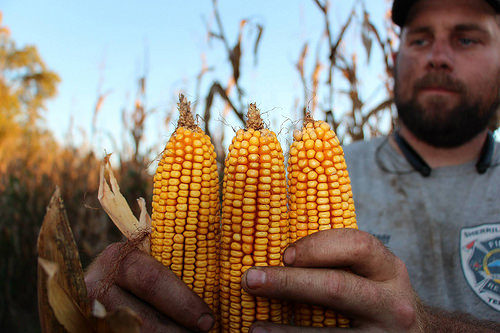Last year, the United States lost 2 million acres of land in active crop production. As the global population grows towards a projected 9.8 billion people by 2050, so too does demand for the food, fuel and fiber grown in America. The result? American farmers are looking for sustainable ways to produce high yields year after year.
To support this growing demand, many farmers are incorporating soil health management principles into their operations. Conservation practices such as cover crops and no-till are widely recommended to build soil health over time, but do these practices actually improve crop yields and lead to stable profit margins? To answer this question fully we will rely on universities, private scientists, government researchers and those most directly impacted: farmers themselves.
Meet Russell Hedrick
Russell Hedrick is a first-generation corn, soybean and specialty grains producer in Catawba County, N.C. Hedrick started in 2012 with 30 acres of row crops. Since then, he’s expanded to roughly 1,000 acres.
“When we first started, farmers in the area said we needed a 150 horsepower tractor and a 20-foot disk,” says Hedrick. “We started out broke and we couldn’t afford the tillage equipment,” he adds, with a good-natured laugh. “I was lucky to have a fantastic district conservationist who set us in the right direction from the beginning.”
His first year, Hedrick practiced 100% no-till and planted cover crops across part of his land. “We tried out a 6 or 7 species cover crop blend,” says Hedrick. “Back then, a lot of people thought we were crazy.”
That initial blend consisted of cereal rye, oats, triticale, legumes, crimson clover and daikon radish. Hedrick compared yields for soybeans grown with cover crops versus those grown without and noticed a significant difference: higher yields for cover cropped beans, and noticeably improved weed suppression.
“We started off our first year seeing yields higher than the county average,” Hedrick says. “That really lit me on fire to keep growing and trying new things to improve the soil health.”
Soil Health Case Studies
Though every farm and every field are different, a recently-completed Natural Resources Conservation Service (NRCS) Conservation Innovation Grants project shows promising results for farmers interested in adopting soil health management practices.
Conducted by the National Association of Conservation Districts (NACD) in partnership with Datu Research, the project provides economic case studies focusing on four corn and soybean producers in the Upper Mississippi River Basin. The profiled farms range in size from 25 acres of row crops to 2,300 acres, with 3 focusing on the economics of cover crop adoption and one specifically focusing on no-till.
Of the 3 farmers focusing on cover crop adoption, 2 reported average net economic gains over their first 4-5 years of cover cropping compared to a pre-adoption baseline. The no-till case study showed economic gains for all three years studied.
Giving Soil Health a Shot
When asked what he’d suggest to farmers considering trying new practices to build soil health, Hedrick’s answer is simple – just give it a shot.
“It’s not that hard to try something new,” says Hedrick. “Farmers should remember that soil hGiealth practices aren’t silver bullets and some take time to establish. When you’re first starting, try no-till or cover crops across 20% of your land. That’s manageable, and it leaves you a safety net if you don’t get the economic results you want to begin with.” Farm Bill programs such as NRCS’s Environmental Quality Incentives Program can further reduce the economic risk farmers face after adopting new conservation practices.
With 318.5 bushels per acre, Hedrick was the dryland division state winner in the 2016 North Carolina Corn Yield Contest. His corn and soybean yields are typically 20-30% higher than the county average, and over time he’s been able to reduce fertilizer costs by more than $70 per acre thanks to the nutrient boosts associated with cover cropping.
“I spend $45 per acre on my best cover crops,” says Hedrick, “and I spend about $20 per acre on my least expensive. Either way, I’m still saving money because of my fertilizer reductions.”
Hedrick encourages farmers to try different practices until they find what works for them. “At the end of the day,” he says, “there’s no one right way to do this. You just have to do the best you can, and try to do better each year. As long as you’re making progress, no one can fault you.”






